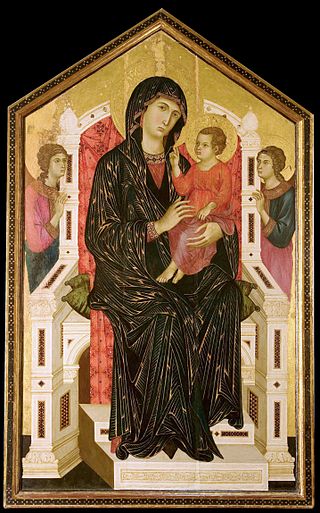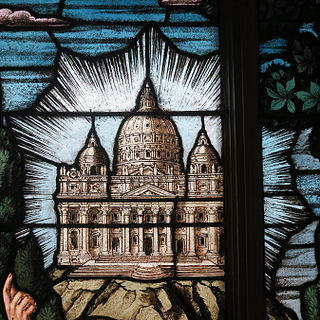
Humanae vitae is an encyclical written by Pope Paul VI and dated 25 July 1968. The text was issued at a Vatican press conference on 29 July. Subtitled On the Regulation of Birth, it re-affirmed the teaching of the Catholic Church regarding married love, responsible parenthood, and the rejection of artificial contraception. In formulating his teaching he explained why he did not accept the conclusions of the Pontifical Commission on Birth Control established by his predecessor, Pope John XXIII, a commission he himself had expanded.

Pope Paul VI was head of the Catholic Church and sovereign of the Vatican City State from 21 June 1963 to his death on 6 August 1978. Succeeding John XXIII, he continued the Second Vatican Council, which he closed in 1965, implementing its numerous reforms. He fostered improved ecumenical relations with Eastern Orthodox and Protestant churches, which resulted in many historic meetings and agreements. In January 1964, he flew to Jordan, the first time a reigning pontiff had left Italy in more than a century.
Gaudium et spes, the Pastoral Constitution on the Church in the Modern World, is one of the four constitutions resulting from the Second Vatican Council in 1966. It was the last and longest published document from the council and is the first constitution published by an ecumenical council to address the entire world. Gaudium et spes clarified and reoriented the role of the church's mission to people outside of the Catholic faith. It was the first time that the church took explicit responsibility for its role in the larger world. The constitution's creation was necessitated by fear of the church's irrelevance in the modern era due to its ignorance on problems that plague the modern world. The document represents an inner examination of the church by the council and features a response to problems affecting the modern world.
Unitatis redintegratio is the Second Vatican Council's decree on ecumenism. It was passed by a vote of 2,137 to 11 of the bishops assembled at the Council, and was promulgated by Pope Paul VI on 21 November 1964.

Nostra aetate, or the Declaration on the Relation of the Church with Non-Christian Religions, is an official declaration of the Vatican II, an ecumenical council of the Catholic Church. It was promulgated on 28 October 1965 by Pope Paul VI. Its name comes from its incipit, the first few words of its opening sentence, as is tradition. It passed the Council by a vote of 2,221 to 88 of the assembled bishops.
The Latin phrase extra Ecclesiam nulla salus is a phrase referring to a Christian doctrine about who is to receive salvation.
Aggiornamento is an Italian word meaning "bringing up to date", "updating". It was made famous by Pope John XXIII, and was one of the key words at the Second Vatican Council, used by both bishops and the media.
Mystici Corporis Christi(The Mystical Body of Christ) is an encyclical issued by Pope Pius XII on 29 June 1943 during World War II. Its main topic is the Catholic Church as the Mystical Body of Christ.
Satis cognitum is an encyclical of Pope Leo XIII dated 29 June 1896 on the unity of the Church, and some heresies of his time.
Ut unum sint is an encyclical by Pope John Paul II of 25 May 1995. It was one of 14 encyclicals issued by John Paul II. Cardinal Georges Cottier, Theologian emeritus of the Pontifical Household, was influential in drafting the encyclical.
Aeterni Patris was an encyclical issued by Pope Leo XIII in August 1879. It was subtitled "On the Restoration of Christian Philosophy in Catholic Schools in the Spirit of the Angelic Doctor, St. Thomas Aquinas". The aim of the encyclical was to advance the revival of Scholastic philosophy.
The Winnipeg Statement is the Canadian Conference of Catholic Bishops' statement on the papal encyclical Humanae vitae from a plenary assembly held at Saint Boniface in Winnipeg, Manitoba. Published on September 27, 1968, it is the Canadian bishops' document about rejecting Pope Paul VI's July 1968 encyclical on human life and the regulation of birth.
Ecclesia de Eucharistia is an encyclical by Pope John Paul II published on April 17, 2003. Its title, as is customary, is taken from the opening words of the Latin version of the text, which is rendered in the English translation as "The Church draws her life from the Eucharist". He discusses the centrality of the Eucharist to the definition and mission of the Church and says he hopes his message will "effectively help to banish the dark clouds of unacceptable doctrine and practice, so that the Eucharist will continue to shine forth in all its radiant mystery." He explored themes familiar from his earlier writings, including the profound connection between the Eucharist and the priesthood. It drew as well on his personal experiences saying Mass.

The theology of Pope Pius XII is reflected in his forty-one encyclicals, as well as speeches and nearly 1000 messages, during his almost 20-year pontificate. The encyclicals Mystici corporis and Mediator Dei advanced the understanding of membership and participation in the Catholic Church. The encyclical Divino afflante Spiritu began opening the door to historical-critical biblical studies. But his magisterium was far larger and is difficult to summarize. In numerous speeches Catholic teaching is related to various aspects of life, education, medicine, politics, war and peace, the life of saints, Mary, the mother of God, things eternal and temporal.

The Mariology of the popes is the theological study of the influence that the popes have had on the development, formulation and transformation of the Roman Catholic Church's doctrines and devotions relating to the Blessed Virgin Mary.

Mariological papal documents have been a major force that has shaped Roman Catholic Mariology over the centuries. Mariology is developed by theologians on the basis not only of Scripture and Tradition but also of the sensus fidei of the faithful as a whole, "from the bishops to the last of the faithful", and papal documents have recorded those developments, defining Marian dogmas, spreading doctrines and encouraging devotions within the Catholic Church.
Mother of the Church is a title given to Mary in the Catholic Church, as officially declared by Pope Paul VI in 1964. The title first appeared in the 4th century writings of Saint Ambrose of Milan, as rediscovered by Hugo Rahner. It was also used by Pope Benedict XIV in 1748 and then by Pope Leo XIII in 1885. Pope John Paul II placed it in the Catechism of the Catholic Church and Pope Francis inserted a feast by this title into the Roman Calendar.
Sister churches was a term used in 20th-century ecclesiology to describe ecumenical relations between the Roman Catholic Church and the Eastern Orthodox Churches, and more rarely and unofficially, between the Roman Catholic Church and the Anglican communion. The Catholic Church has since called on theologians to avoid the term, clarifying that "one cannot properly say that the Catholic Church is 'sister' of a particular Church or group of Churches. This is not merely a question of terminology, but above all of respecting a basic truth of the Catholic faith: that of the unicity [uniqueness] of the [Catholic Church]." The term is also currently used among Protestants to refer to different denominations of the same religious tradition.
In Christian theology, a supernatural gift is a gift of God that is conferred on man that is above all the powers of created nature. An example of this is the gift of grace, which enables man to attain salvation despite original sin.

Catholic ecclesiology is the theological study of the Catholic Church, its nature, organization and its "distinctive place in the economy of salvation through Christ". Such study shows a progressive development over time being further described in revelation or in philosophy. Here the focus is on the time leading into and since the Second Vatican Council (1962–1965).







